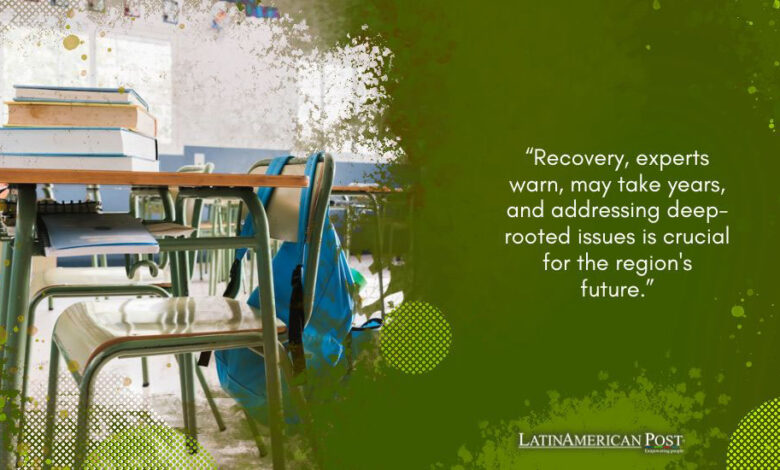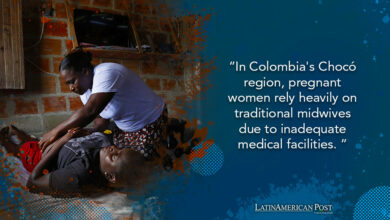Pandemic Deepened Latin America’s Longstanding Educational Crisis and Inequity

Latin America’s education system faces a profound crisis, worsened by the COVID-19 pandemic. Recovery, experts warn, may take years, and addressing deep-rooted issues is crucial for the region’s future.
Latin America is grappling with a severe educational crisis, a problem that has been plaguing for decades but was sharply exacerbated by the COVID-19 pandemic. This crisis has led to significant setbacks in learning, with the World Bank estimating that recovery may take up to four years. Jaime Saavedra, the World Bank’s Director of Human Development for the region, highlighted these concerns in a recent interview, emphasizing the urgent need for comprehensive educational reform.
For the past 40 years, Latin America has made strides in increasing school enrollment rates, particularly at the primary level. However, Saavedra pointed out that high enrollment rates have yet to translate into effective learning outcomes. “Many of those children are not learning,” he remarked, underscoring a fundamental educational system flaw. This longstanding “learning crisis” has only worsened during the pandemic, which forced the closure of schools and disrupted education for nearly two years.
Before the pandemic, 52% of 10-year-olds in Latin America could not read or understand a simple text. According to the World Bank, this figure has now surged to 70%. The pandemic-induced school closures led to significant learning losses and increased dropout rates, particularly among the most vulnerable populations.
Historical Context and Challenges
Latin America’s educational challenges are deeply rooted in the region’s history. Socioeconomic inequalities, political instability, and insufficient investment in education have created a fragile system. Colonial legacies left many countries with underdeveloped infrastructures and significant disparities in access to quality education. Over time, efforts to modernize and improve educational systems must be more consistent and often underfunded.
The pandemic highlighted and amplified these pre-existing issues. Schools in disadvantaged areas lacked the resources to transition to remote learning effectively, widening the educational gap between affluent and poor communities. The digital divide became glaringly apparent, with many students needing access to technology and internet connectivity for online education.
Saavedra stresses that one of the most urgent needs is to improve the quality of teacher training. Effective education relies heavily on well-trained, motivated teachers who understand their critical role in shaping students’ futures. While governments have made some efforts to enhance teacher training, these have been partial and insufficient. Comprehensive programs that equip teachers with modern pedagogical skills and support their professional development are essential.
Improving school infrastructure is also crucial. Many schools across Latin America suffer from inadequate facilities, lack of essential resources, and overcrowded classrooms. Investment in technology, learning materials, and safe, conducive learning environments is necessary to ensure students receive a quality education.
The Impact of the Pandemic
The pandemic’s impact on education in Latin America was profound. School closures were a “gigantic shock” for students, many of whom now face a two—to three-year learning delay. This setback is not merely a pause but a regression, as students forget what little they had learned before the pandemic. Saavedra emphasizes that more than simply returning to pre-pandemic educational practices will be necessary. Countries must engage in an active recovery process to address these deficits.
Sustained and consistent investment in education is vital for recovery. Governments must prioritize education in their budgets, ensuring that funding reaches the most critical areas, such as teacher training, infrastructure, and learning materials. Additionally, policies must be implemented to address the high dropout rates, especially at the secondary level, where less than half of the students complete their education.
A uniform approach to educational standards across the region could help mitigate disparities. Saavedra suggests that Latin American countries adopt standard criteria for academic quality and outcomes, fostering collaboration and shared strategies for improvement.
The Road Ahead: Sustainable Development Goals
Achieving the fourth Sustainable Development Goal (SDG 4) – ensuring inclusive, equitable, and quality education for all – appears increasingly unlikely for Latin America by the 2030 deadline. Even before the pandemic, the region was far from meeting these targets. Saavedra candidly acknowledges this reality, urging governments and stakeholders to set realistic yet ambitious goals to make tangible progress.
The educational crisis in Latin America has far-reaching implications. Education is a cornerstone of economic development and social stability. Without significant improvements, the region risks perpetuating cycles of poverty and inequality. Education empowers individuals, fosters innovation, and promotes civic participation. Therefore, addressing this crisis is not only an educational imperative but also a social and economic one.
Latin America’s Unique Challenges
Latin America’s educational crisis cannot be detached from its broader socio-political context. The region’s history of inequality, political turbulence, and economic instability continues to affect its educational systems. Corruption and mismanagement have often diverted resources from critical public services like education. Moreover, the persistence of social inequalities means that marginalized communities, including indigenous and rural populations, are disproportionately affected by educational shortcomings.
Countries like Uruguay and Chile have made notable strides in improving their educational systems, offering valuable lessons for the rest of the region. Uruguay’s Plan Ceibal, which provides laptops to students and teachers, has significantly enhanced digital literacy and access to educational resources. Chile’s focus on teacher quality and performance-based incentives has led to measurable improvements in student outcomes.
These examples demonstrate that progress is possible with the right policies and investments. However, scaling these successes across diverse and often resource-constrained contexts remains a significant challenge.
The Role of International Organizations
International organizations, including the World Bank and UNESCO, play a critical role in supporting Latin American countries in overcoming their educational challenges. They provide funding, technical assistance, and a platform for sharing best practices. Collaborative initiatives and partnerships can mobilize resources and foster innovation in educational approaches.
Latin America’s educational crisis demands urgent and sustained action. The COVID-19 pandemic has exposed and exacerbated longstanding issues but has also created an opportunity for reform and renewal. By investing in teacher training, improving infrastructure, and adopting consistent educational standards, the region can begin to recover and build a more resilient educational system.
Also read: Cybersecurity Challenges Highlight Latin America’s Digital Vulnerabilities
Governments, international organizations, and civil society must work together to ensure that every child in Latin America has access to quality education. This is not only a moral imperative but a strategic one, crucial for the region’s future prosperity and stability. The path to recovery is long and challenging, but with commitment and collaboration, Latin America can overcome this crisis and provide its children with the education they deserve.





